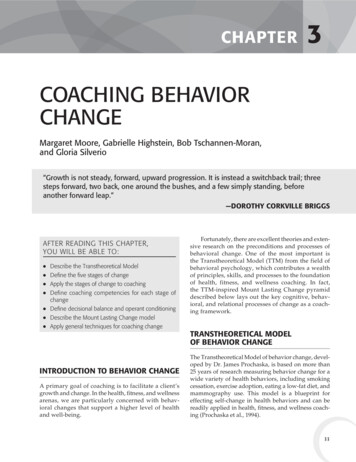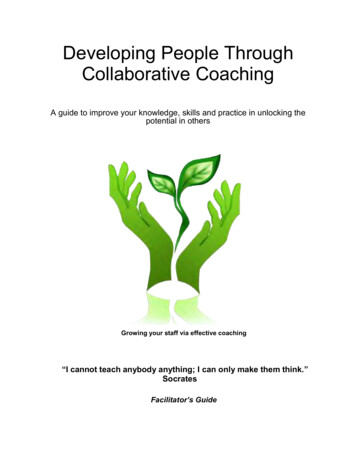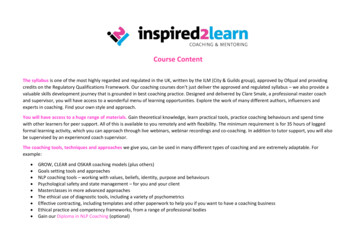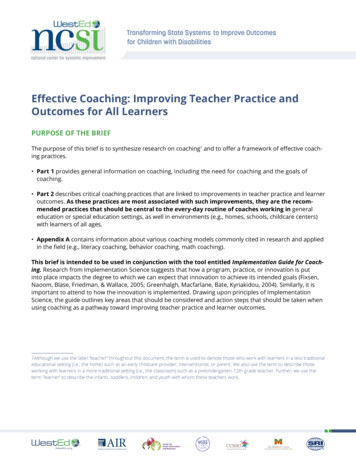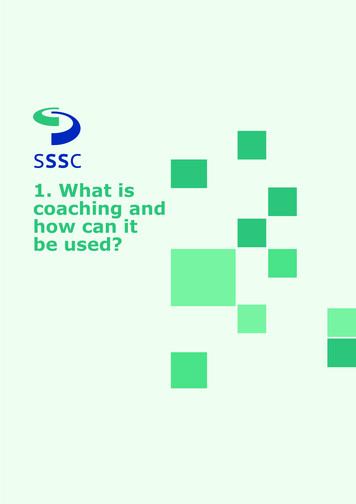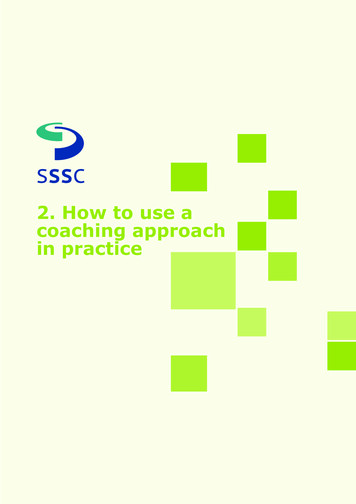
Transcription
Chapter 3: Coaching BehaviorChangeConfidentialPage 1 of 559/1/2005
Chapter 3Coaching Behavior Change"Growth is not steady, forward, upward progression. It is instead aswitchback trail; three steps forward, two back, one around the bushes,and a few simply standing, before another forward leap."— Dorothy Corkville BriggsChapter Contributors: Margaret Moore, Gabrielle Highstein, BobTschannen-Moran, and Gloria SilverioAfter reading this chapter, you will be able to: Describe the Transtheoretical Model Define the five stages of change Apply the stages of change to coaching Define coaching competencies for each stage of change Define decisional balance and operant conditioning Describe the Mount Lasting Change Model Apply general techniques for coaching changeIntroduction to Behavior ChangeA primary goal of coaching is to facilitate a client’s growth and change.In the health, fitness, and wellness arenas we are particularly concernedwith behavioral changes which support a higher level of health and wellbeing.ConfidentialPage 2 of 558/3/21012
Fortunately, there are excellent theories and extensive research on thepreconditions and processes of behavioral change. One of the mostimportant is the Transtheoretical Model (TTM), from the field ofbehavioral psychology, which contributes a wealth of principles, skills,and processes to the foundation of health, fitness, and wellnesscoaching. In fact, the TTM-inspired Mount Lasting Change pyramiddescribed below lays out the key cognitive, behavioral, and relationalprocesses of change as a coaching framework.Transtheoretical Model of Behavior ChangeThe Transtheoretical Model of behavior change (TTM), developed byDr. James Prochaska, is based on more than twenty-five years ofresearch measuring behavior change for a wide variety of healthbehaviors, including smoking cessation, exercise adoption, eating a lowfat diet, and mammography use. This model is a blueprint for effectingself-change in health behaviors, and can be readily applied in health,fitness, and wellness coaching. (Prochaska, et.al., 1994).Your clients may have decided to employ a coachbecause they already recognize they need andwant to adopt new fitness, wellness, and health-The five stages of changemodel, developed by Dr.Prochaska, providecoaches with anunderstanding of how andwhen behaviors can bealtered and why clientsmay struggle, fail, or quit.related behaviors – and they are committed todoing so. Health and wellness behavior change isConfidentialPage 3 of 558/3/21012
particularly challenging, particularly today (see page 4). If it were easy,your clients probably would not be seeking your help or would havealready made and sustained the changes they need and desire.Research has shown that self-change is a staged process. We movefrom not thinking about changing a behavior, to thinking about it, toplanning to change, and to testing out ways to do it before we actuallystart.Using inappropriate techniques that prematurely encourage newbehaviors can discourage change. For example, people who have notyet made up their mind to change are not sufficiently ready to adoptbehavioral strategies. Applying this kind of pressure can cause them towithdraw from the change process.To avoid such an outcome, it is important to identify the stage of changethat clients may be in when they first come to coaching for each area inhealth, fitness, and wellness This approach relates less to their outlookon life than to their readiness to change a specific behavior. Clients willtypically be in different stages of change for different areas or behaviors(e.g., eating habits, physical activity, stress coping, positive self-talk, orrelaxation practices).It is also important to recognize that your client may move forwardtoward action or may slip back toward inaction during the time you areworking together. When you are aware of the stage your clients are in,you can apply techniques for assisting change that are specific andeffective for the stage they are in. Application of specific techniques atConfidentialPage 4 of 558/3/21012
each stage will help you coach your clients to reach their health, fitness,and wellness goals more quickly and effectively and be able to maintainthem.Stages of Change and Effective Coaching Skills for Each StageThe stages that people move through are very predictable andidentifiable, beginning with the precontemplation stage whereindividuals are not yet thinking about making change, all the waythrough to the maintenance stage where changes have been adoptedas a way of life. The characteristics people exhibit at each stage aredistinct and recognizable.The five stages of change are:1. Precontemplation (Not Ready For Change)2. Contemplation (Thinking About Change)3. Preparation (Preparing for Action)4. Action (Taking Action)5. Maintenance (Maintaining a Good Behavior)IMPORTANTMost of your client prospects will be in the contemplation and/orpreparation stage for at least one area (fitness, weight, nutrition, stress,mental or physical health) and your coaching program will help themreach the maintenance phase (sustaining the new behavior consistentlyweek to week) within 3-6 months. You may be able to help them moveConfidentialPage 5 of 558/3/21012
forward in areas where they are pre-contemplators when openingsemerge in the coaching discussions. Also, when clients progress in onearea, their confidence in self-change grows and they may become readyto move forward in another area.1. Precontemplation : “I won’t” or “I can’t”When someone is not even thinking about adopting a healthy behavior,it’s usually because they fall into one of two categories of people: the “IWon’t” or the “I Can’t” people. The “I Won’t” people are not interested inchanging because they do not feel they have a problem. Family andfriends may feel otherwise and may be nagging them about it, but theyfail or refuse to see the problem. The “I Can’t” people would like tochange but they don’t believe it’s possible. For very different reasons,both kinds of people are not even contemplating, let alone working on,making a change when it comes to that area of their lives.Coaching skills to use in the precontemplation stage:To move forward, precontemplators first need sincere empathy fromtheir coaches. This is the time to use reflections to show that youunderstand and respect their feelings and needs. Your ability torecognize and to accept that they do not intend to change a particularbehavior is the key to future possibilities. You are not asking them tomove forward on the change process at this time. Instead you arefocused on understanding them at a deep level without judgment or fearConfidentialPage 6 of 558/3/21012
(for additional material on empathy using Nonviolent Communication,see Chapter 5).For most “I Won’t” people this is the important message. I understandthat you are not ready right now. That is fine. Here is how you cancontact me if you decide at some point that you are ready. You leaveclients feeling good about the interaction so they will think about you ina positive light. You do not make them feel judged or that they areinadequate.The “I Can’t” people are aware they have a problem and need tochange, but they believe change is too complicated and/or difficult. Theymay have tried and failed in the past. These people are acutely aware oftheir barriers and need help to look at the barriers in a positive andrational way so they can learn from them rather than beingoverwhelmed by the negative emotions generated by past failures.With a coach, clients can sort their barriers into those that are real andneed to be put to the side right now, those that are excuses, and thosethat can be overcome by a strong enough motivator. Taking realbarriers, for which time may have to elapse before resolution, off thetable can lower the client’s emotional level. The client doesn’t have toconvince you, the coach, about the barrier. This acceptance showsyour clients that you are on their side. The client is then much readier towork with you to find a strong, positive motivator. When a client hassomething they really want and they know that this change will give it tothem, they are far more motivated to work on finding solutions tobarriers that have tripped them up in the past.ConfidentialPage 7 of 558/3/21012
2. Contemplation: “I may”We call the Contemplation Stage the “I May” Stage. At this stage, clientsare thinking about changing an unhealthy behavior or adopting ahealthy behavior – and are considering taking action within the next sixmonths. They are more aware of the benefits inherent in changing andless satisfied with their present health and well-being than theprecontemplators.They may express a fair amount of ambivalence about change, feelingthat change will be difficult or even impossible to achieve. People canremain in this stage for a long time and become chronic contemplatorsbecause they cannot imagine themselves behaving differently and/orthey do not know how to change. They are still weighing the benefits ofchange against the effort it will take.When openings emerge with “I May” people, you may be able to exploretheir best experiences with change in the past as well as the positivereasons for doing a particular behavior in the future. By focusing on theirvalues and vision, they may come to appreciate how change wouldimprove their life. When appropriate, coaches can share importantscientific facts about the benefits of the behavior and can assist clientsto discover the pros that might serve as positive and even powerfulmotivators for change.ConfidentialPage 8 of 558/3/21012
Coaching skills to use in the contemplation stage: Help clients move beyond the contemplation stage by connectingthem to their strengths and assisting them to get excited aboutchange. The discovery work alone may be enough to move themto the next stage of change. Increasing their awareness ofcompelling reasons to change and getting them to connect withpeople who have successfully made the change are keymotivational strategies. Assist these clients to connect the dots between the changes theyseek and the values they hold. Setting behavioral change in thislarger context makes the change more meaningful and significant. If clients have not sufficiently identified their personally compellingmotivators to change, including new supportive relationships andnew reasons to change, help them to think this through. A clearvision of what they want (not what they don’t want) is essential. Help your clients examine not only the upside but also thedownside of giving up old behaviors for new, healthier behaviors.Identify which barriers are real and which can be worked out.Normalize, don’t catastrophize. Help these clients identify and to accomplish small, realisticthinking and feeling goals every week, thereby empowering themto be more confident in their ability to change. A series of smallsuccesses builds self-efficacy. Remember that, at this stage, the small goals will involve reading,thinking, talking, listening, discovering, and deciding – not doing abehavior.ConfidentialPage 9 of 558/3/21012
IMPORTANTTo move contemplators into preparation and then into action, be surethey: Find strong motivators Understand their challenges Identify possible solutions or strategies for moving forward3. Preparation: “I will”This is known as the “I Will” Stage. In the Preparation Stage,ambivalent feelings have been largely overcome. Clients havestrengthened their motivation and they are planning to take some actionwithin the next month. These clients have a strong motivator. Theyknow what their barriers are and they have come up with some possiblesolutions. If these thinking tasks are not accomplished then they arestill in Contemplation. During this stage, clients experiment with theirpossible solutions, discard the ones that do not work and think up newapproaches.Coaching skills to use in the preparation stage: Help your clients move through the preparation phase by assistingthem to concretize their plans for change. Encourage them towrite down a formal statement of what they are committingthemselves to do, containing specific details of what, when, andhow.ConfidentialPage 10 of 558/3/21012
Help your clients by brainstorming and identifying lots of smallsteps they can take that are actionable and realistic.Brainstorming can be done together, with both the coach and theclient coming up with ideas. If clients exhibit ambivalence or resistance to change, help themto explore the difficulties of doing the new behaviors andencourage them to identify ways to work these out. Do not add tothe resistance by telling clients what to do. Discuss situations clients think could be problematic when theyactually start the behavior, and have them develop strategies tocope before the situation arises.4. Action: “I am”The action stage is known as the “I Am” Stage. In this stage, clientshave identified the new behavior that they want to establish and aredoing it consistently, building up to the target level. For example, theymay be working toward meeting the ACSM definition of cardiovascularexercise, which suggests that exercise be done 3–5 times a week for20–60 minutes at a time at a moderate to high level of intensity. Or, theymay be meeting whatever specific set of dietary criteria their physicianshave prescribed for them.During this stage, which lasts up to six months, clients are working onbuilding new relationships, practicing new behaviors, and establishingnew habits. They may have to concentrate very hard while practicingthe new behaviors and refining their lifestyles. The bulk of coachingConfidentialPage 11 of 558/3/21012
generally takes place with people who are in this stage, as well as in thepreparation stage.IMPORTANT:Since there is a high risk of lapse and relapse back to preparation at thisstage, techniques to manage challenging situations are important. Notethat there is a distinction between lapse and relapse. A lapse is a singleslip in a desired behavior that may or may not lead to a relapse.Whether a lapse becomes a relapse depends on the individual’sresponse to lapses, their perceived loss of control, and their socialnetwork.A coach can help the client explore their challenging situation and tolearn from it. Who were they with? Where were they? What was goingon? How were they feeling? What can they do differently next time?Such questions lead to the formation of a relapse prevention plan whichthe client can have in their proverbial back pocket for the next time theyare challenged.Assisting clients to develop new relationships with people who sharetheir interests and behavioral goals can make a significant difference.With the right modeling and support, lapses will seldom becomerelapses. Without modeling and support, as clients attempt to “go italone” and “figure it out for themselves,” lapses can easily trigger adownward spiral. Coaching is itself a new relationship, but it usuallytakes a community of interests to support long-term behavior change.Coaches should encourage the formation of such new alliances.ConfidentialPage 12 of 558/3/21012
Coaching skills to use in the action stage: Help these clients to connect their new behaviors with theirstrengths, values, and preferred environments (including socialnetworks). The more modes of support they can identify thebetter. Target gradual changes and small achievable steps that assistclients to feel successful early. Encourage clients to develop new relationships with people whoshare their interests and behavioral goals. Anticipate and be prepared for lapses. Help these clients reframe a lapse as a temporary setback. Assist clients to frame mistakes as learning opportunities ratherthan as failures. Learn from all mistakes to minimize the chanceof them happening again. Help these clients move away from an all-or-nothing mentalityabout their goals, which only leads to guilt, self-blame, and anexcuse to quit. Unless clients are ready to take a bold step forward, whichsometimes happens, it is usually best to avoid high-risk situationsthat unduly test a client’s new skills and behaviors. Conduct a planned lapse, such as a day without exercise or ameal where they eat whatever they want, to develop new mentalskills, perspective, and resilience under a controlled situation. Discuss situations that could be problematic when they actuallystart the behavior. Have clients develop strategies to cope withthese situations before they actually come up.ConfidentialPage 13 of 558/3/21012
5. Maintenance: “I still am”This is the “I Still Am” stage. This stage begins when the new behaviorchange has become a habit and is done automatically – usually sixmonths after the initial behavior has changed. Clients are nowconfident that they can maintain the new behavior, and would rate theirconfidence to maintain the new behavior at a level of 8 or 9 out of 10. Inthis stage, their self-efficacy is both high and self-reinforcing.Just because clients progress to the maintenance level does not meanthey don’t need to continue working diligently to maintain the behavior.(Nor does it necessarily mean that they will no longer need or want acoach.) There are a different set of risks in maintenance, includingboredom and the danger of gradually slipping back into old, lesshealthful habits.Lapses, where people temporarily abandon new behaviors, can occurduring the maintenance period just as easily as during the action stage.If and when this happens, people often need assistance to set newgoals and get refocused. For example, they may benefit from signingup and training for an event, taking up a new type of exercise, or tryinga competitive sport. This can be easier in maintenance, than in action,since they have already come to experience the value and benefits oftheir new behavioral patterns. Lapses in this stage don’t usually produceany significant alteration in the health and fitness benefits of thebehavior change, which means people can more easily and quickly getConfidentialPage 14 of 558/3/21012
back on track. Learning to make such adjustments is, indeed, a sign ofbeing in the maintenance stage of change.Relapses are more problematic in any stage of change. As extendedabandonments of new behaviors, such as a new eating regimen orexercise program, relapses lead to the reduction or even to thedisappearance of benefits. To reverse a relapse, it is important toreconnect clients with their strengths, values, resources, vision, goals,and motivators. Instead of doing a root-cause analysis on whathappened, it is better to restart the preparation and action process withjudgment-free listening, inquiries, and reflection. The more vividly clientscan remember and reconnect with their capacity to put their strengths towork, the more they will develop their self-efficacy and regain theirsense of control.Coaching skills to use in the maintenance stage: Assist these clients to reconnect and appreciate the value of newbehaviors in serving their vision and goals. Challenge clients to keep growing, by setting new behavioralgoals that are both interesting and attainable. Assist these clients to establish social networks and otherenvironmental support mechanisms. Never lose sight of the motivators that brought clients to coachingin the first place. Help clients discover new motivators if theirs were time limited.ConfidentialPage 15 of 558/3/21012
Encourage clients to share their health-promoting commitmentsand behaviors with others. It is motivating to be a positive rolemodel. If and when lapses happen, encourage early recognition and rapidresponses to get back on track. Avoid judgment at all times, especially when clients have lapsed. If and when relapses happen, go back to using the coaching skillsfor preparation and action. As clients get back on track with their desired behaviors, developrelapse-prevention plans that will assist them to cope withpotential derailments.The five stages of change are illustrated by Figure 3.1, from the Centersfor Disease Control and Prevention; it makes clear that lapses andrelapses are a normal part of the change process.ConfidentialPage 16 of 558/3/21012
(Source: Table 3.1 provides a summary of the coaching skills that are useful foreach stage of change with reference to the International CoachFederation’s Core Coaching Competencies (Chapter 2).ConfidentialPage 17 of 558/3/21012
StageSkills to UseExplanationListeningWe've all been there, and the client needs to know weEmpathyunderstand their feelings and needs. This is not the timeAcceptanceto judge but to empathize. Compassion, "to suffer with," isInquirythe operative word. Accepting people right where theyReflectionsare, without lecturing them about where they ought to be,Affirmationwill build the trust and intimacy so necessary to being aReframingcatalyst for change. (See ICF Core Competencies 3 & 4)PreContemplation:I Won'tSharingBrainstormingThe I wont’s need to bolster their appreciation of the pros.MI (Chapter 5)I Can’tListeningI can’ts need to bolster their confidence for overcomingEmpathythe cons. We can also offer to help them sort through theirAcceptancebarriers.InquiryReflectionsEveryone in pre-contemplation needs not only reasonsAffirmationwhy but also hope when it comes to the prospects forReframingchange.SharingSorting barriersAI (Chapter 4)Contemplation:I MightConfidentialListeningContemplators need to get in touch and stay connectedEmpathywith their strengths, core values, and intrinsic motivationAcceptancefor change. Identifying strengths, values, and motivatorsInquirywill assist contemplators to complete the wellness visionPage 18 of 558/3/21012
Reflectionscoaching process, giving them more clarity on where theyAffirmationwant to go and why.ReframingSharingContemplators need to find strong motivators. They needBrainstormingto understand their barriers and to have come up withAI (Chapter 4)possible solutions. Accomplishing these three thinkingMI (Chapter 5)tasks moves contemplators forward into preparation.Self-Efficacy &Sharing information as well as stories related to theSelf-Esteempossibilities for and benefits of making a change can(Chapter 6)make an invaluable contribution to the client’s changeprocess (See ICF Core Competencies 7 & 8).Preparation:I WillListeningOnce people have strong motivation, know their barriersEmpathyand have thought of some possible solutions, it's time forInquirythe coach to work with them on designing actions (ICFReflectionsCore Competencies 9 & 10). This starts with exploringAffirmationtheir positive core (AI, Chapter 4) through powerfulAI (Chapter 4)questioning (ICF Core Competency 6). Although we mayBrainstormingwant to teach them the tricks to being successful, it'sExperimentingbetter to assist them to discover, design, commit to, andCommittingexperiment with their own strategies for success. ThoseHonoringare the ones that will stick.TestingSchedulingAction:I AmConfidentialListeningIf ever there were a time for a coach to be a cheerleaderInquiryand a champion, it's in the action stage of change. TheReflectionsclient has started on the path – they need our confidence,Affirmationenergy, and commitment to believe they can stay on thePage 19 of 558/3/21012
(Support)Inspiration(Challenge)path (ICF Core Competency 9). We walk a tightrope here,between support and challenge. Clients need to beinspired. Too much support and we baby them; too muchNormalizingchallenge and we overwhelm them. To inspire them, weCalibratingkeep just the right amount of tension on the line.ReengineeringEnvironmentalDesignAs clients run into challenging situations, coaches helpthem explore those situations and come up with relapseprevention plans.Maintenance:I Still AmListeningIf it takes 21 days to develop a new habit, it may take 21Inquirymonths to develop a new lifestyle. During the process,Reflectionsclients will discover new and exciting things aboutAffirmationthemselves; they will also encounter challenges and(Support)Inspiration(Challenge)setbacks, as well as boredom and discouragement.Helping clients develop into role models for others is apowerful way to stay motivated.ModelingImprovisationBy being flexible, creative, and inventive, coaches canCreativityassist clients to stay engaged. This is part and parcel ofIntrinsicmanaging progress and accountability (ICF CoreRewardsCompetency 11), which may be too heavy for someclients to handle without continued experimentation andimprovisation (ICF Core Competency 9).Helping Clients Move through the Stages of ChangeAfter establishing trust and rapport, with an orientation around a client’spositive core, you will want the client to tell you (rather than for you totell them) what stage of readiness they believe they are in with regard toConfidentialPage 20 of 558/3/21012
their areas of focus: e.g., physical activity, eating, weight management,stress management, mental and physical health, or any life issuesrelated to their health and well-being. This alone can generatewonderful conversation as to why they picked the stage they picked,what got them to where they are, and what goals or behaviors that wantto focus on first in moving forward. Once their stage of change isrecognized and their initial behavioral goals are identified, you can applythe coaching skills and techniques appropriate to their readiness forchange.NOTE: The Readiness to Change quiz (see Appendix A) can be usedwith clients to prioritize the behaviors they want to change and rate theirconfidence in their ability to change.The conversation essentially flows according to the following pattern: Explore the client’s positive core, including their characterstrengths, core values, and primary motivators / reasons forchange. Co-identify their stage of change and one or more appropriatebehavioral goals. Co-design strategies that will promote quick-wins and self-efficacywith those behavioral goals. Discuss challenges, as appropriate, that may interfere withbehavior change and stimulate thought about possible solutions. Elicit client commitments as to the steps they will take and theefforts they will make in the week ahead.ConfidentialPage 21 of 558/3/21012
Reconfirm their readiness to change and willingness to moveforward.Remember that you don’t have to get clients to use the formal names ofthe stages themselves. It is often better, in fact, to simply have clientschoose the descriptive statement that best describes where they arewith respect to changing a particular behavior: I won’t do it I can’t do it I may do it I will do it I am doing it I am still doing itMore on the Transtheoretical Model (TTM)James Prochaska, PhD, recognized that some people were ready tochange and others were not, and that different strategies had to be usedfor people in different stages of readiness. After surveying a widevariety of different psychotherapeutic models, Prochaska and hiscollaborators put together the “Transtheoretical Model” or “TTM” toidentify what processes worked best for people in different stages ofchange.Carlo DiClemente, in his PhD dissertation, identified ten such processesthat describe what people actually do to change. Five are CognitiveProcesses and five are Behavioral Processes of change.ConfidentialPage 22 of 558/3/21012
Processes of ChangeCognitive processes encompass a wide range of reflective-learningprocesses in which people are sorting out their thoughts, feelings, anddesires regarding a particular health-promoting change. Theseprocesses, which often take place over a period of several months oreven years, include:1. Getting Information: Finding out about all the benefits (e.g.,medical and lifestyle) of doing a behavior.2. Being Moved Emotionally: Taking to heart the health effects of abehavior and using them to ignite your drive to change.3. Considering How Your Behavior Affects Others: For example,thinking through what your children may be learning fromwatching you perform a behavior.4. Self-Image: Connecting the dots and seeking congruencebetween one’s vision, values, and behaviors in order to enhanceintegrity.5. Social Norms: Connecting and talking with like-minded peoplewho are all working on the same behavior (e.g., a support orspecial-interest group).Behavioral processes encompass a wide range of action-orientedlearning processes in which people are experimenting with new healthpromoting behaviors and adopting the ones that work. These processesinclude:ConfidentialPage 23 of 558/3/21012
1. Making a Commitment: For example, writing down exactly whatnew behavior will be done and when.2. Using Cues: For example, designing environmental reminders todo what is planned.3. Using Substitution: Replacing an old health-risky behavior with anew health-promoting behavior (e.g. substituting carrot sticks or astraw for a cigarette).4. Social Support: Recruiting family and friends to help withbehavior change by specifically asking each of them to considerthe particular thing you would like them to do for you. Thisrequires clients to think carefully about what they would likesomeone to do and then to ask the person on their support teamto do it.5. Rewards: Setting up ways to be rewarded or rewarding yourselffor completing your weekly action goals.Decisional BalanceAn effective way to engage clients in the processes of change,especially the Cognitive Processes, is to get them to weigh the pros andcons of a particular behavior or behavioral change. Known as aDecisional Balance (Janis & Mann, 1977), such weighing increases thechance of successful behavior change by taking into consideration: The Pros or gains for self, gains for others, approval of other, andself-approval. The Cons or losses for self, losses for others, disapproval ofothers, and self disapproval.ConfidentialPage 24 of 558/3/21012
Pros / Benefits / Motivators are the good things about doing a newhealth
self-change in health behaviors, and can be readily applied in health, fitness, and wellness coaching. (Prochaska, et. al., 1994). Your clients may have decided to employ a coach because they already recognize they need and want to adopt new fitness, wellness, and health


